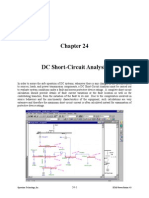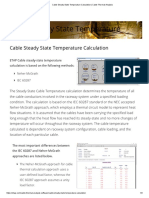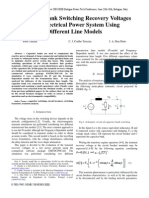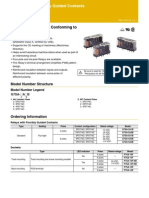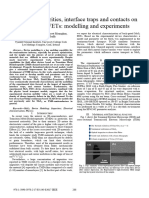DC Short CKT Calculation
DC Short CKT Calculation
Uploaded by
Ravishankar.AzadCopyright:
Available Formats
DC Short CKT Calculation
DC Short CKT Calculation
Uploaded by
Ravishankar.AzadOriginal Description:
Original Title
Copyright
Available Formats
Share this document
Did you find this document useful?
Is this content inappropriate?
Copyright:
Available Formats
DC Short CKT Calculation
DC Short CKT Calculation
Uploaded by
Ravishankar.AzadCopyright:
Available Formats
Proceedings of the 7th WSEAS International Conference on Power Systems, Beijing, China, September 15-17, 2007
153
Verification of the calculation procedures for evaluation of short-circuit currents in 220 VDC auxiliary system of TPP Rijeka
Sejid Tenjak, Javor kare, Nikola vigir Department of Power Systems University of Zagreb, Faculty of Electrical Engineering and Computing, Zagreb, Unska 3 Republic of Croatia sejid.tesnj http://www.fer.hr
Abstract: - DC auxiliary systems are usually relied upon as the last source of reliable electric power at an installation of power plants and substations. Because DC auxiliary systems and battery power sources differ from AC systems, it is important that DC system protection designer is aware of their special considerations. In Standard IEC 61660-1 is given mathematical model for dynamics analysis in DC auxiliary systems of power plants and substations. In this paper, the authors performed short-circuit currents calculation in real DC auxiliary system of TPP Rijeka using mathematical mode defined in standard IEC 61660-1. Calculation results were verified on site during DC circuit breakers selectivity testing. Key-Words: - DC auxiliary systems, thermal power plant (TPP), substations, mathematical model, short-circuit, circuitbreaker, selectivity.
1 Introduction
DC auxiliary systems are usually relied upon as the last source of reliable electric power at an installation of power plants and substations. That is the reason why the transient behavior of DC auxiliary systems has recently gained great interest. The greatest effort in standardization of DC short-circuit current calculation is represented by standard IEC 61600-1, Calculation of Short-Circuit Currents in DC auxiliary installations in power plants and substations. Using mathematical model for dynamics analysis in DC auxiliary systems defined in this IEC Standard, short-circuit currents calculation in real DC auxiliary system of TPP Rijeka was performed. Calculation results were verified on site during 220 VDC circuit breakers selectivity testing.
Feeder Power Transformer Commutation Feeder connection cable reactor point
Threephase bridge
Smoothing reactor
Line
Z N = RN + j X N RQ,X Q Q Rp ,X p RT ,X T RR X R
Un
RS
LS
RDL
L DL
RN = RQ + Rp + RT + RR X N = X Q+ X p + X T + X R Rectifier branch
Line Common branch
RB Lead-acid battery EB
+
LB
RBL
L BL
RY Fx
LY Fy
Line
RC Capacitor EC
+ -
RCL
L CL
Field
Armature
Line
RF DC motor EF
+ -
LF
+
RM EM M
-
LM
RML
L ML
2 Evaluation of short-circuit currents
Fig. 1 equivalent circuit diagram of the DC auxiliary system
2.1 Mathematical model for dynamics analysis in accordance with the IEC 61600-1
Mathematical model for short-circuit current evaluation in DC auxiliary systems considers following items that are sources of possible contribution to the fault current: rectifiers in three-phase AC bridge stationary lead-acid battery smoothing capacitors DC motors. The equivalent circuit diagram of DC auxiliary systems under study is shown in Fig.1.
The approximation function for each short-circuit current of the above-mentioned four sources is describe by
i1 (t) = i p 1e 1e
t 1 tp 1
, 0 t tp
t t p 2
(1)
i 2 (t) = i p [(1 p) e
p = Ik Ip
+ p], t p t
(2) (3)
Proceedings of the 7th WSEAS International Conference on Power Systems, Beijing, China, September 15-17, 2007
154
RECTIFIER LH 220V, 200A KONAR C=4x9,9 mF
The total short-circuit current is found by superimposing the partial short-circuit currents from different sources at the short-circuit location. The approximation function for total short-circuit current is described by
i tot ( t ) = jipj
j=1 m
Cu cable 95 mm2, 1 m CUBICLE OF RECTIFIER 220 V DC
1 e 1 e
t ij t pj 1 j
0 t tpj
(4)
MAIN DC DISTRIBUTION 220 V DC F1 LOAD SWITCH 630 A II LEVEL MCCB, NS100N "MG" TM 40D II LEVEL MCCB, NS160N "MG" TM 125D
m i tot ( t ) = jipj (1 p j ) e j=1
( t t pj ) 2 j
+ pj
tpj t TK
(5)
p =
I kj I pj
(6)
Fig. 2 block diagram of the 220 VDC auxiliary system in TPP Rijeka
where i(t) is the total short-circuit current j is the numeral of voltage source m is the number of source Tk is the short-circuit duration j is correction factor of j-voltage source
2.2 Calculation of short-circuit currents in the 220 VDC auxiliary system of TPP Rijeka
Block diagram of the 220 VDC auxiliary system in TPP Rijeka is shown in Fig.2. Calculation of maximum shortcircuit currents are made on fault locations F1, F2, F3, and F4 by using mathematical model described in
Calculation results which describe time variation of the short circuit current in the first 10 ms after short-circuit was occurred are given in table 1 for fault location F1, in table 2 for fault location F2, in table 3 for fault location F3 and in table 4 for fault location F4. Since in this case the contribution of rectifier in total short-circuit current was higher than the contribution of emergency lube oil pump, in tables 1-4 are shown calculation results only for short-circuit currents with parallel operation of three sources; battery, rectifier and capacitors. In Fig. 3 is shown calculated variation of total shortcircuit currents during the first 10 ms for fault location F1-F4.
where Ik quasi-steady-state short-circuit current ip peak current tp time to peak 1, 2 rise and decay time constants These characteristic values are defined for each different source once certain electrical parameters (i.e., resistance, reactance, etc.) and nominal voltage are known and by using some correction factors evaluated on an experimental basis. Detail references about theoretical background can be found in Standard IEC 61600-1 (1997-06). The total short-circuit current for the location FX in Fig. 1 is obtained by adding short-circuit current of all sources without correction factor and for location FY in Fig. 1 by adding the partial short-circuit current modified by means of correction factor j that is needed because in that case there is a common branch (RY and LY 0). Formulas for calculation of partial contributions of different sources can be found in Standard IEC 61600-1 (1997-06), too.
section 2.1. Thereby following switching and operating conditions are taken into account: The conductor resistances are referred to a temperature of 20 C; The joint resistance of busbars are neglected; The control for limiting the rectifier current is not effective; All sources are connected to busbars but initial load is neglected; Any diodes for decoupling parts of system are neglected; The battery is charged to full capacity; The current limiting effect of circuit breakers are taken into account; Parallel operation of rectifier and emergency lube oil pump is impossible.
AC, 400/230 V, 50 Hz BATTERY Powersafe DDm 125-25 105 cl, 1500 Ah I LEVEL MCCB, Tmax T5 S "ABB" TMA 400 A Cu cables 2x95/pol mm2, 15 m Cu cable 120 mm2, 130 m M ST EMERGENCY LUBE OIL PUMP 220 V, 19,2 kW
LOAD SWITCH 630 A
LOAD SWITCH 630 A
Cu cables 2x95/pol mm2, 70 m
F2 Cu kabel 6 mm2, 23 m F3 III LEVEL MCB C6A F4
Proceedings of the 7th WSEAS International Conference on Power Systems, Beijing, China, September 15-17, 2007
155
Table 1 Short-circuit current in F1
Contrib. of rectifier 73 138 196 246 291 331 365 396 423 447 Contrib. of battery 3245 4975 5897 6388 6650 6790 6864 6902 6898 6895 Contrib. of capacitor 2194 1320 794 477 287 173 104 62 38 23
Table 4 Short-circuit current in F4
itot (A)
5513 6433 6886 7112 7228 7293 7333 7361 7359 7365 ik (A) t=1 ms ik (A) t=2 ms ik (A) t=3 ms ik (A) t=4 ms ik (A) t=5 ms ik (A) t=6 ms ik (A) t=7 ms ik (A) t=8 ms ik (A) t=9 ms ik (A) t=10 ms Contrib. of rectifier 6 11 16 20 24 27 30 32 35 36 Contrib. of battery 655 654 654 654 653 653 653 652 652 652 Contrib. of capacitor 233 216 200 185 172 159 147 136 126 117
ik (A) t=1 ms ik (A) t=2 ms ik (A) t=3 ms ik (A) t=4 ms ik (A) t=5 ms ik (A) t=6 ms ik (A) t=7 ms ik (A) t=8 ms ik (A) t=9 ms ik (A) t=10 ms
itot (A)
894 882 870 859 849 839 830 821 813 805
Table 2 Short-circuit current in F2
Contrib. of rectifier 33 62 87 110 130 147 163 177 189 199 Contrib. of battery 2318 2940 3107 3146 3144 3142 3140 3137 3135 3133 Contrib. of capacitor 1010 750 556 413 306 227 169 125 93 69
itot (A)
3361 3751 3750 3669 3580 3516 3471
A 8000 7000 6000 5000 4000 3000 2000 1000
i tot (loc. F1)
ik (A) t=1 ms ik (A) t=2 ms ik (A) t=3 ms ik (A) t=4 ms ik (A) t=5 ms ik (A) t=6 ms ik (A) t=7 ms ik (A) t=8 ms ik (A) t=9 ms ik (A) t=10 ms
i tot (loc. F2) i tot (loc. F3) i tot (loc. F4)
1 2 3 4 5 6 7 8 9 10 11 12 ms
3439 3417 3402
Table 3 Short-circuit current in F3
Contrib. of rectifier 15 29 40 51 60 68 75 82 87 92 Contrib. of battery 993 1017 1017 1016 1016 1015 1015 1014 1014 1013 Contrib. of capacitor 354 316 281 251 223 199 177 158 141 126
Fig. 3 Time variation of total short-circuit current in locations F1-F4 during first 10 ms itot (A)
1362 1361 1338 1318 1299 1282 1267 1254 1242 1231
ik (A) t=1 ms ik (A) t=2 ms ik (A) t=3 ms ik (A) t=4 ms ik (A) t=5 ms ik (A) t=6 ms ik (A) t=7 ms ik (A) t=8 ms ik (A) t=9 ms ik (A) t=10 ms
3 Testing of circuit-breakers selectivity and recording of short-circuit currents on site
Circuit breaker selectivity testing was performed on site at the end of reconstruction of 220 VDC auxiliary system in TPP Rijeka. Short circuit was generated in all fault locations where short circuit currents were calculated (Fig.2, fault locations from F1 to F4). Time variations of short circuit currents were recorded by oscilloscope. Circuit breaker selectivity was checked for characteristic disposition of circuit-breakers in 220 VDC installation. 1. level; Tmax T5 S, TMA 400, I1=0,7xIn, I2=7,5 xIn, ABB 2. level; NS100N, TM40D, I1=0,8xIn, I2=12,5xIn, Merlin Gerin 3. level; C32HDC, C-6 A
Proceedings of the 7th WSEAS International Conference on Power Systems, Beijing, China, September 15-17, 2007
156
s 10000 7000 5000 3000 2000 1000 700 500 300 200 100 70 50 30 20 10 7 5 3 2 1 0.7 0.5 0.3 0.2 0.1 0.07 0.05 0.03 0.02 0.01 0.007 0.005 0.003 0.002 0.001 1 2 3 4
C32H-DC-C6A
NS100/TM40
T5-TMA 400
fig. 5 time variations of short-circuit current in location F1
5 7 10 1 2 3 4 5 7 10 2 2 3 4 5 7 10 3 2 3 4 5 7 10 4 A
Fig. 4 Breaking I-t curves for circuit breakers situated in three protection level
I-t curves of three circuit-breakers situated in different protection levels of 220 VDC auxiliary installation are shown in fig. 4. We can see that time selectivity is ensured for low short-circuit currents. For verifying selectivity at high short-circuit currents we performed selectivity testing on site. Circuit breaker selectivity testing in TPP Rijeka verified selected circuit breakers disposition up to maximum short-circuit current 3300 A for circuit breakers situated in the first and the second level and up to maximum short-circuit current 680 A for circuit breakers situated in the second and the third level. In Fig. 5-8 are shown testing results for variation of total short-circuit currents during the breaking of fault in all observed fault locations. In case recorded in fig. 5, shortcircuit current was broken by circuit-breaker situated in protection level 1 (Tmax, ABB), in fig. 6 and 7 by circuit-breaker situated in protection level 2 (NS100N, MG), and in fig. 8 by circuit-breaker situated in level 3 (miniature CB).
fig. 6 time variations of short-circuit current in location F2
fig. 7 time variations of short-circuit current in location F3
Proceedings of the 7th WSEAS International Conference on Power Systems, Beijing, China, September 15-17, 2007
157
fig. 8 time variations of short-circuit current in location F4
in Power Plants and Substations, ISCAS 2003, Bangkok, Thailand, 2003. [6] S. Skok, A. Marui, S. Tenjak: Transient Short Circuit Currents in Auxiliary DC Installations in Power Plants and Substations, PowerTech 2003, Bologna, Italy, 2003. [7] S. Skok, S. Tenjak, M. Vuljankovi: Analysis of Auxiliary DC Installations in Power Plants and Substations According to Draft International Standard IEC - 1660, MELECON '98, Tel-Aviv, Izrael, 1998. [8] J.P. Nereau: Discrimination with LV power circuitbreakers, E/CT 201, 2001.
We can compare time-current curves recorded during the testing, shown in fig. 5-8, with calculated time-current curves, shown in fig. 3. They are corresponding in the first segment of curves before arching voltage on CB breaking contacts appears. However, the magnitude of short-circuit currents measured during the test is about 510 % lower than we expected according to calculation results.
4 Conclusion
This paper has described calculation procedures for evaluation of short-circuit currents in 220 VDC auxiliary system of TPP Rijeka. Mathematical model for dynamics analysis was based on IEC 61600-1. Calculation results are compared with real short-circuit currents on site during 220 VDC circuit breakers selectivity testing. The comparison has shown an overall agreement between the two sets of results, with a general overestimation about 5-10% on the safety side by calculation results.
References: [1] IEC 61660-1, Short circuit currents in DC auxiliary installation in power plants and substations Part 1: Calculation of short circuit currents, 1997 [2] A.Berizzi, A. Silvestri, Dario Zaninelli and Stefano Massucco, Evaluation of IEC Draft Standard Through Dynamic Simulation of Short-Circuit Currents in DC Systems, IEEE transactions on industry applications, vol. 34, NO. 1, January/February 1998 [3] IEEE Guide for the Protection of Stationary Battery System IEEE STD: 1375-1998, 1998. [4] IEEE Recommended Practic for the Design of DC Auxiliary Power Systems for Generating Stations, IEEE STD: 946-1992., 1992. [5] S. Skok, A. Marui, S. Tenjak: Electrical Protection Selectivity in Auxiliary DC Installations
You might also like
- Revision Guide Chemistry 7J: Current Electricity Exploring Science PAGE 151 TO 165No ratings yetRevision Guide Chemistry 7J: Current Electricity Exploring Science PAGE 151 TO 1657 pages
- 3 Winding Transformer Impedance Calculation in IEC Short Circuit StudyNo ratings yet3 Winding Transformer Impedance Calculation in IEC Short Circuit Study4 pages
- ETAP FAQ - Governor Limit Checking in Transient Stability Studies100% (1)ETAP FAQ - Governor Limit Checking in Transient Stability Studies1 page
- Transformer Tap Setting in Optimal Load FlowNo ratings yetTransformer Tap Setting in Optimal Load Flow7 pages
- DC Short Circuit Classical and IEC 61660No ratings yetDC Short Circuit Classical and IEC 6166037 pages
- Cable Thermal Analysis Short Circuits EANo ratings yetCable Thermal Analysis Short Circuits EA19 pages
- (Power Engineering 33) Das, J. C-Power System Analysis - Short-Circuit Load Flow and harmonics-CRC Press (2012) - 1-1 PDFNo ratings yet(Power Engineering 33) Das, J. C-Power System Analysis - Short-Circuit Load Flow and harmonics-CRC Press (2012) - 1-1 PDF1 page
- Calculation For Short Circuit Current Calculation Using IEC IEEE Standard PDF100% (1)Calculation For Short Circuit Current Calculation Using IEC IEEE Standard PDF11 pages
- ETAP Workshop Notes Load Flow Analysis: Purpose and DescriptionNo ratings yetETAP Workshop Notes Load Flow Analysis: Purpose and Description14 pages
- Sequence Impedance in Different Power Equipments50% (2)Sequence Impedance in Different Power Equipments7 pages
- ETAP PS 7 Arc Flash Calculation MethodologyNo ratings yetETAP PS 7 Arc Flash Calculation Methodology29 pages
- Etap - Key Points For Load Summary, Part 4: Lumped Load ApplicationsNo ratings yetEtap - Key Points For Load Summary, Part 4: Lumped Load Applications2 pages
- System Analysis With The MVA Method For Symmetrical Three-Phase FaultsNo ratings yetSystem Analysis With The MVA Method For Symmetrical Three-Phase Faults6 pages
- FINAL Harmonic Study Report - HJI - First Phase100% (2)FINAL Harmonic Study Report - HJI - First Phase37 pages
- Calculate Size of Neutral Earthing Transformer (NET) - Electrical Notes & ArticlesNo ratings yetCalculate Size of Neutral Earthing Transformer (NET) - Electrical Notes & Articles5 pages
- ETAP - Cable Steady-State Temperature Calculation - Cable Thermal AnalysisNo ratings yetETAP - Cable Steady-State Temperature Calculation - Cable Thermal Analysis3 pages
- High Voltage Electric Equipment Failure DiagnosisNo ratings yetHigh Voltage Electric Equipment Failure Diagnosis37 pages
- Service Manual Type MYTU 04 Field Failure RelayNo ratings yetService Manual Type MYTU 04 Field Failure Relay28 pages
- Arc Flash Hazard Calculations in DC Systems R1No ratings yetArc Flash Hazard Calculations in DC Systems R136 pages
- ETAP Workshop Notes Short Circuit Analysis: Theoretical Concepts100% (1)ETAP Workshop Notes Short Circuit Analysis: Theoretical Concepts13 pages
- Why Is X/R Ratio Important?: Figure 1 Sample Simple Circuits With Different X/R Ratios100% (1)Why Is X/R Ratio Important?: Figure 1 Sample Simple Circuits With Different X/R Ratios3 pages
- Verification of The Calculation Procedures For Evaluation of Short-Circuit PDFNo ratings yetVerification of The Calculation Procedures For Evaluation of Short-Circuit PDF5 pages
- 3.6 The Design of Harmonic Filter and Reactive Power Compensation in Power Supply SystemNo ratings yet3.6 The Design of Harmonic Filter and Reactive Power Compensation in Power Supply System5 pages
- Design Note: Optimizing Performance in Uc3854 Power Factor Correction ApplicationsNo ratings yetDesign Note: Optimizing Performance in Uc3854 Power Factor Correction Applications42 pages
- Application Note - Co-Ordination of Protection DeviceNo ratings yetApplication Note - Co-Ordination of Protection Device8 pages
- Structural Steel and Fire - More Realistic AnalysisNo ratings yetStructural Steel and Fire - More Realistic Analysis8 pages
- Current, Potential Difference & Resistance 2No ratings yetCurrent, Potential Difference & Resistance 217 pages
- Experiment No. 1 Analysis of Resistive Networks ObjectivesNo ratings yetExperiment No. 1 Analysis of Resistive Networks Objectives12 pages
- Which Types of Questions Are Asked in An ETO InterviewNo ratings yetWhich Types of Questions Are Asked in An ETO Interview3 pages
- Moam - Info - Silicon Vlsi Technology Fundamentals Practice and - 1No ratings yetMoam - Info - Silicon Vlsi Technology Fundamentals Practice and - 11 page
- LM4051 Precision Micropower Shunt Voltage Reference: Literature Number: SNOS491CNo ratings yetLM4051 Precision Micropower Shunt Voltage Reference: Literature Number: SNOS491C16 pages
- 48V Bus Bar Connectors & Cable Assemblies: IntroducingNo ratings yet48V Bus Bar Connectors & Cable Assemblies: Introducing1 page
- Electrical Circuits 1 1.1 Atomic Theory of MatterNo ratings yetElectrical Circuits 1 1.1 Atomic Theory of Matter12 pages
- Chapter 2 (Basic Electrical Quantities System of Units Circuit Components)No ratings yetChapter 2 (Basic Electrical Quantities System of Units Circuit Components)75 pages
- Technical Service Information: Nissan/Infiniti/Mercury100% (1)Technical Service Information: Nissan/Infiniti/Mercury10 pages
- 3300 16 MM High Temperature Proximity System: ManualNo ratings yet3300 16 MM High Temperature Proximity System: Manual48 pages
- User Guide_Light Switch ZB15S and Outlet ZB15R A0 181211No ratings yetUser Guide_Light Switch ZB15S and Outlet ZB15R A0 1812111 page
- Impact of Impurities, Interface Traps and Contacts On MoS2 MOSFETs - Modelling and ExperimentsNo ratings yetImpact of Impurities, Interface Traps and Contacts On MoS2 MOSFETs - Modelling and Experiments4 pages
- Guidelines On Electrochemical Corrosion Measurements: European Federation of Corrosion PublicationsNo ratings yetGuidelines On Electrochemical Corrosion Measurements: European Federation of Corrosion Publications62 pages
- AIPMT-NEET Previous Year Solved Paper 2002No ratings yetAIPMT-NEET Previous Year Solved Paper 200216 pages
- Revision Guide Chemistry 7J: Current Electricity Exploring Science PAGE 151 TO 165Revision Guide Chemistry 7J: Current Electricity Exploring Science PAGE 151 TO 165
- 3 Winding Transformer Impedance Calculation in IEC Short Circuit Study3 Winding Transformer Impedance Calculation in IEC Short Circuit Study
- ETAP FAQ - Governor Limit Checking in Transient Stability StudiesETAP FAQ - Governor Limit Checking in Transient Stability Studies
- (Power Engineering 33) Das, J. C-Power System Analysis - Short-Circuit Load Flow and harmonics-CRC Press (2012) - 1-1 PDF(Power Engineering 33) Das, J. C-Power System Analysis - Short-Circuit Load Flow and harmonics-CRC Press (2012) - 1-1 PDF
- Calculation For Short Circuit Current Calculation Using IEC IEEE Standard PDFCalculation For Short Circuit Current Calculation Using IEC IEEE Standard PDF
- ETAP Workshop Notes Load Flow Analysis: Purpose and DescriptionETAP Workshop Notes Load Flow Analysis: Purpose and Description
- Etap - Key Points For Load Summary, Part 4: Lumped Load ApplicationsEtap - Key Points For Load Summary, Part 4: Lumped Load Applications
- System Analysis With The MVA Method For Symmetrical Three-Phase FaultsSystem Analysis With The MVA Method For Symmetrical Three-Phase Faults
- Calculate Size of Neutral Earthing Transformer (NET) - Electrical Notes & ArticlesCalculate Size of Neutral Earthing Transformer (NET) - Electrical Notes & Articles
- ETAP - Cable Steady-State Temperature Calculation - Cable Thermal AnalysisETAP - Cable Steady-State Temperature Calculation - Cable Thermal Analysis
- ETAP Workshop Notes Short Circuit Analysis: Theoretical ConceptsETAP Workshop Notes Short Circuit Analysis: Theoretical Concepts
- Why Is X/R Ratio Important?: Figure 1 Sample Simple Circuits With Different X/R RatiosWhy Is X/R Ratio Important?: Figure 1 Sample Simple Circuits With Different X/R Ratios
- Verification of The Calculation Procedures For Evaluation of Short-Circuit PDFVerification of The Calculation Procedures For Evaluation of Short-Circuit PDF
- 3.6 The Design of Harmonic Filter and Reactive Power Compensation in Power Supply System3.6 The Design of Harmonic Filter and Reactive Power Compensation in Power Supply System
- Design Note: Optimizing Performance in Uc3854 Power Factor Correction ApplicationsDesign Note: Optimizing Performance in Uc3854 Power Factor Correction Applications
- Application Note - Co-Ordination of Protection DeviceApplication Note - Co-Ordination of Protection Device
- Structural Steel and Fire - More Realistic AnalysisStructural Steel and Fire - More Realistic Analysis
- Experiment No. 1 Analysis of Resistive Networks ObjectivesExperiment No. 1 Analysis of Resistive Networks Objectives
- Which Types of Questions Are Asked in An ETO InterviewWhich Types of Questions Are Asked in An ETO Interview
- Moam - Info - Silicon Vlsi Technology Fundamentals Practice and - 1Moam - Info - Silicon Vlsi Technology Fundamentals Practice and - 1
- LM4051 Precision Micropower Shunt Voltage Reference: Literature Number: SNOS491CLM4051 Precision Micropower Shunt Voltage Reference: Literature Number: SNOS491C
- 48V Bus Bar Connectors & Cable Assemblies: Introducing48V Bus Bar Connectors & Cable Assemblies: Introducing
- Chapter 2 (Basic Electrical Quantities System of Units Circuit Components)Chapter 2 (Basic Electrical Quantities System of Units Circuit Components)
- Technical Service Information: Nissan/Infiniti/MercuryTechnical Service Information: Nissan/Infiniti/Mercury
- 3300 16 MM High Temperature Proximity System: Manual3300 16 MM High Temperature Proximity System: Manual
- User Guide_Light Switch ZB15S and Outlet ZB15R A0 181211User Guide_Light Switch ZB15S and Outlet ZB15R A0 181211
- Impact of Impurities, Interface Traps and Contacts On MoS2 MOSFETs - Modelling and ExperimentsImpact of Impurities, Interface Traps and Contacts On MoS2 MOSFETs - Modelling and Experiments
- Guidelines On Electrochemical Corrosion Measurements: European Federation of Corrosion PublicationsGuidelines On Electrochemical Corrosion Measurements: European Federation of Corrosion Publications











